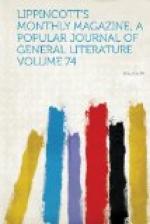The natives of this region are characterized by marked peculiarities of the anatomical frame. The elongation of the bones, the contour of the facial angle, the relative proportion or disproportion of the extremities, the loose muscular attachment of the ligatures, and the harsh features were exemplified in the notable instance of the late President Lincoln. A like individuality appears in their idiom. It lacks the Doric breadth of the Virginian of the other slope, and is equally removed from the soft vowels and liquid intonation of the southern plain. It has verbal and phraseological peculiarities of its own. Bantering a Tennessee wife on her choice, she replied with a toss and a sparkle, “I-uns couldn’t get shet of un less’n I-uns married un.” “Have you’uns seed any stray shoats?” asked a passer: “I-uns’s uses about here.” “Critter” means an animal—“cretur,” a fellow-creature. “Longsweet-’nin’” and “short sweet’nin’” are respectively syrup and sugar. The use of the indefinite substantive pronoun un (the French on), modified by the personals, used demonstratively, and of “done” and “gwine” as auxiliaries, is peculiar to the mountains, as well on the Wabash and Alleghany, I am told, as in Tennessee. The practice of dipping—by which is meant not baptism, but chewing snuff—prevails to a like extent.
In farming they believe in the influence of the moon on all vegetation, and in pork-butchering and curing the same luminary is consulted. Leguminous plants must be set out in the light of the moon—tuberous, including potatoes, in the dark of that satellite. It is supposed to govern the weather by its dip, not indicate it by its appearance. The cup or crescent atilt is a wet moon—i.e., the month will be rainy. A change of the moon forebodes a change of the weather, and no meteorological statistics can shake their confidence in the superstition. They, of course, believe in the water-wizard and his forked wand; and their faith is extended to the discovery of mineral veins. While writing this I see the statement in a public journal that Richard Flannery




